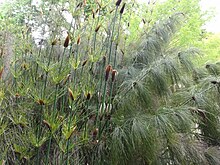
Back رستيونية Arabic رستيونيه ARZ Restionaceae AST Restionaceae Azerbaijani Restionaceae BS Restionàcies Catalan Restionaceae CEB Lanovcovité Czech Restionaceae German Restionacoj Esperanto
| Restionaceae Temporal range: Late Cretaceous-Recent,
| |
|---|---|

| |
| Elegia capensis | |
| Scientific classification | |
| Kingdom: | Plantae |
| Clade: | Tracheophytes |
| Clade: | Angiosperms |
| Clade: | Monocots |
| Clade: | Commelinids |
| Order: | Poales |
| Family: | Restionaceae R.Br. |
The Restionaceae, also called restiads and restios, are a family of flowering plants native to the Southern Hemisphere; they vary from a few centimeters to 3 meters in height. Following the APG IV (2016):[1] the family now includes the former families Anarthriaceae, Centrolepidaceae and Lyginiaceae, and as such includes 51 genera with 572 known species.[2] Based on evidence from fossil pollen, the Restionaceae likely originated more than 65 million years ago during the Late Cretaceous period, when the southern continents were still part of Gondwana.[3][4]
- ^ Angiosperm Phylogeny Group (2016), "An update of the Angiosperm Phylogeny Group classification for the orders and families of flowering plants: APG IV", Botanical Journal of the Linnean Society, 161 (2): 1–20, doi:10.1111/boj.12385
- ^ Christenhusz, M. J. M. & Byng, J. W. (2016). "The number of known plants species in the world and its annual increase". Phytotaxa. 261 (3): 201–217. doi:10.11646/phytotaxa.261.3.1.
- ^ Bremer, K. (2002). "Gondwanan Evolution of the Grass Alliance of Families (Poales)." Evolution, 56(7): 1374-1387. [1] Archived 2013-07-28 at the Wayback Machine
- ^ Linder, H. P. (1987). "The Evolutionary History of the Poales/Restionales: A Hypothesis". Kew Bulletin. 42 (2): 297. doi:10.2307/4109686. ISSN 0075-5974.